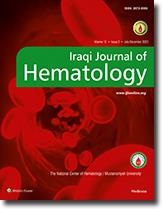Abstract
Abstract:
Chronic myeloid leukemia (CML), as the name suggests, is a chronic disorder in which granulocytes
undergo dysregulated production and uncontrolled proliferation. Majority of CML patients present
during the chronic phase (CP) of the disease. The interval from CP to onset of blastic transformation
and acute leukemia can vary from days to several years. The biological basis of blast phase is
poorly understood. Most common blast crisis is myeloid type and less frequently lymphoid or
promyelocytic. The transformation of CML to promyelocytic blast crisis is a rare form. These findings
suggest that BCR‑ABL1 gene arises from leukemic stem cell (LSC) which is still not committed to
myeloid or lymphoid differentiation. The blastic clone may originate either at the multipotent LSC
or at committed leukemia progenitor cell. Here, we report a case of promyelocytic blast crisis with
t(15;17) in addition to t(9;22).
Chronic myeloid leukemia (CML), as the name suggests, is a chronic disorder in which granulocytes
undergo dysregulated production and uncontrolled proliferation. Majority of CML patients present
during the chronic phase (CP) of the disease. The interval from CP to onset of blastic transformation
and acute leukemia can vary from days to several years. The biological basis of blast phase is
poorly understood. Most common blast crisis is myeloid type and less frequently lymphoid or
promyelocytic. The transformation of CML to promyelocytic blast crisis is a rare form. These findings
suggest that BCR‑ABL1 gene arises from leukemic stem cell (LSC) which is still not committed to
myeloid or lymphoid differentiation. The blastic clone may originate either at the multipotent LSC
or at committed leukemia progenitor cell. Here, we report a case of promyelocytic blast crisis with
t(15;17) in addition to t(9;22).
Keywords
Acute promyelocytic leukemia
BCR/ABL
Chronic Myeloid Leukemia
Imatinib
PML/RARa
